|
Getting your Trinity Audio player ready...
|
OWN VOICE ~ InPerspective by Gregg Diegez.
Coming in the midst of a deadly and expensive Pandemic, the proposed water and sewer services rate increases by Montara Water and Sanitary District (MWSD) are generating significant rate payer opposition. In addition to my natural interest as a ratepayer, I have been asked by neighbors to look into this issue. The purpose of this article is to assess the District’s need for those rate increases.
The Bottom Line
With over $250 million in assets under management, MWSD requires cash flow of over $6 million a year to replenish those assets, assuming a 40 year average life. Even WITH the proposed rate increases, my projections show the district can only support about $3 million a year in capital expenditures. There is no doubt in my mind the District needs these funds. The open questions are: A) how soon, and B) how much MORE funding the District will require, and how it’s going to get it.
The Big Picture
Last time I looked, of the 39 largest cities in India, only one (1) had running water 24/7. Civilization Is Expensive.
The American Water Works Association has estimated that nationally, water rates are going to triple in coming years, and that the increase will be greater in the West. Originally, MWSD staff requested funding for water system capital expenditures of $2 million annually. The District has rate study projections which justify the rate increases. After reviewing the impact on ratepayers, the Directors agreed to fund only $1 million, and created a hardship funding program for qualifying residents. The Water System Reliability Charge proposed is an additional $558.66 for a normal house.
Is that too much to pay? To help decide let’s look at both national statistics and the characteristics of the local infrastructure in comparison to other agencies (below, under Little Picture). The American Water Works Association (AWWA) considers water and sewer costs in relation to the midpoint household income in a given district. AWWA benchmarks for Median Water and Sewer rates are shown below, along with the Median Annual Household Income for our areas. Compare your water and sewer costs with the dollars in the far right column in the table below. You will have to evaluate for yourself whether MWSD’s rates are ‘affordable’. Likely, most of us will find that we are in the higher 25% of costs nationwide.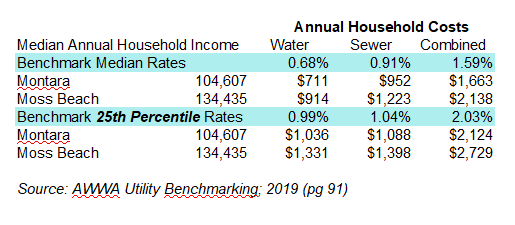 Those costs come from owning and operating the water and sewer infrastructure of pipes, pumps, tanks, filters, etc. MWSD has over $250 million dollars of assets (in 2019 dollars) under management, as shown in the diagram below. Assets are shown divided between water production and delivery, sewer collection and delivery, sewage treatment and discharge, and administrative functions. The sewer assets
Those costs come from owning and operating the water and sewer infrastructure of pipes, pumps, tanks, filters, etc. MWSD has over $250 million dollars of assets (in 2019 dollars) under management, as shown in the diagram below. Assets are shown divided between water production and delivery, sewer collection and delivery, sewage treatment and discharge, and administrative functions. The sewer assets
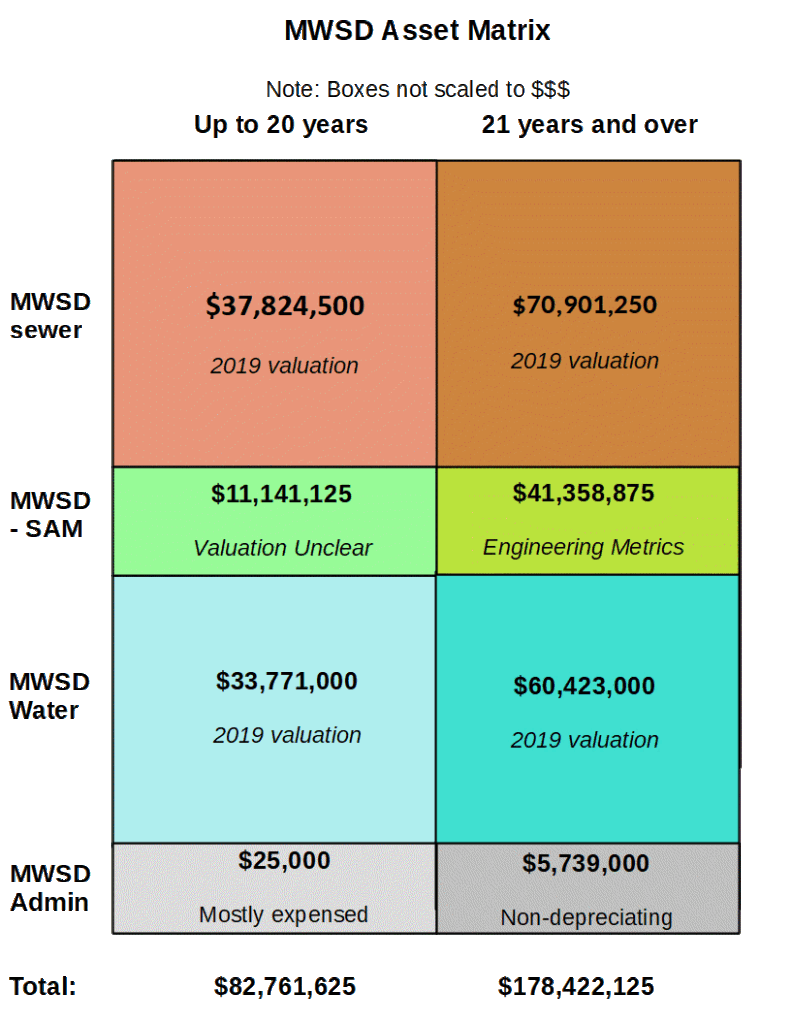
include about a 21% share of the Sewer Authority Mid-coast (SAM) assets – which is jointly owned by MWSD, El Granada (GCSD), and the city of Half Moon Bay.
In Public Works, every asset must be continually replenished. Some assets can last 60 or 80 years, others 40, or 20, or less. As detailed in a report by Resist Density, a large proportion of MWSD sewer pipes are over 40 years old. About a third of MWSD assets have a remaining life of less than 20 years. If we assume an average life of 40 years for all District assets, that implies annual asset replenishment funding of $6 million. [Note that over a 40 year timeframe, 20 year assets will have to be replaced TWICE, and that the costs will be increased by inflation[1] My independent projections show that the district – WITH the rate increases – can support $3 million annually in asset replenishment – only half of the $6 million replenishment required. So, the district will have to continually juggle and extend asset lifetimes for the foreseeable future, and hope not to repeat past problems.
One funding option is borrowing. The District currently has over $17 million in debt service outstanding. The problem with borrowing is at least threefold: A) you have to repay the money, B) you pay more because of interest and fees, C) loans come with covenants which often: 1) require some funds be reserved for repayments (so you can’t use all the money you just borrowed), 2) establish constraints on future borrowing, and 3) dictate requirements for rate increases in order to underwrite the loan. Thus, there is ‘no free lunch’ with borrowing. One relevant amusing anecdote came from a former Board member who remembered back in the 70’s when the Federal government subsidized 7/8ths of expenditures related to the Clean Water Act, but “no one realized that we were going to have to replace those assets”. There seems to be a pervasive bias nationally to forget that in Public Works “once an asset, always an asset”, and to set rates with a very short term outlook in response to natural public downward pressure on rates, ignoring the inevitability of asset replenishment.
The Little Picture
There are several things MWSD is criticized for. High legal costs, high rates, sewer system overflows, and being contentious. I can’t speak knowledgeably to all of those issues, without more evidence about what caused the lawsuits in which MWSD is embroiled. It was openly discussed at SAM board meetings that HMB, while under stress from a potential $40 million lawsuit in about 2009[2], would not fund its share of SAM’s preventative maintenance of the Inter-tie Pipeline System (IPS) because they “didn’t benefit from it”. The IPS brings sewage from Montara, Moss Beach, and El Granada to the treatment plant at the Sewer Authority Midcoast (SAM), and eventually ruptured in 2017 during record rains, resulting in a large spill, and in fines and funding requirements imposed by regulators. That inter-tie is designed with upstream sewage expansion tanks that allow SAM operators to turn off the flow from the north during heavy rains, and allow HMB to consume 100% of the SAM treatment plant capacity – which has happened at least twice in recent years. When that northern flow is terminated, the sewage backs up miles into the IPS, and into expansion tanks in Montara and El Granada. That was the original design of the SAM system, and in fact the expansion tanks were not proportionately funded by HMB for some reason. I am not privy to the lawsuit discussions held in closed session, but it appears to me that those lawsuits did not stem from MWSD mismanagement. There certainly could be grounds for changes in SAM cost assessments, with HMB now above 55% usage of the SAM plant, and other factors to be determined. In summary, it appears MWSD has absorbed about $250,000 of extra legal fees in the past 3 years, from both the lawsuits related to SAM, and from its efforts to obtain additional water rights.
Further, two other factors have impacted costs at MWSD beyond normal inflation in Public Works Construction. First is a regulatory change on water from the Airport wells, which required additional filtration be put in place to prevent nitrates from agriculture leaking into that water supply. Apparently the district has not detected any nitrates in those wells for over a decade, but regulations require 30 years of ‘all clear’ evidence to preclude adding the additional filtration. The result was a capital expenditure, and ongoing filtration costs, of about $500,000. Finally, a plague of those non-flushable wipes which people keep flushing (you’ve seen the signs telling you to NOT flush them), caused a recent pump failure and replacement. This is a pervasive problem; there are photos of VW-sized clogs in major city sewer mains caused by those wipes. With the large number of pumps MWSD has, it is especially vulnerable to those pests.
I also reviewed the extensive use of consultants at MWSD. The District has a manager, operations, and administration staff totaling eight full-time employees. While it requires water and sewer engineering, hydrology, accounting, and legal services, MWSD is not large enough to either need or afford that specialized staff full-time, so it relies upon consultants on an as-needed basis. This is common practice for districts of its size. This is one area where I believe the District could make a modest reduction in expenses, and it appears they are doing so in the next budget iteration. On the whole, I find the operation lean, and certainly the Grand Jury report in 2016 which reviewed six independent districts, did not find any waste at MWSD.[3]
There is an open question about whether there would be cost savings from consolidation of smaller local districts. My interviews and literature review lead me to believe there would be no cost savings (aside from legal fees 😆) from consolidation, but that a basic change in Governance at SAM would result in more goal-congruent and cost-effective decision-making (and fewer lawsuits) . But this is a complex issue for another article. For the short to medium term, I find the expenses of the District relevant and responsible to their mission.
MWSD certainly has some challenges compared to other districts. It is in a marine environment, which ages materials more rapidly. It operates in hilly terrain from its own, unique water source, as opposed to more gravity-operated infrastructures elsewhere which are less expensive to operate.[4] It does not have the same level of commercial and property tax revenue of other local districts – being largely funded by residential rate-payers. As a result, rates here are higher, and will likely remain so. But it will be interesting, after CV-19, to conduct a similar analysis on the capital adequacy of the other Coastside water and sewer agencies, now that tourism revenue has turned down…
Background and Approach
While I am not a Board member, I am a frequent attendee to their meetings the past several years, with a background in finance, and I have taken a hobby-like interest in trying to understand how Growth, Infrastructure, and Sustainability interact in our society. What elevated my interest was a rough analysis I did in July, 2018 which forecast that all four of our local water and sewer agencies would be bankrupt in 20 years (MWSD, GCSD, SAM, and CCWD) if current financial dynamics remained unaltered. Since then, I have interviewed dozens of practitioners: Public Works Managers, Engineers & Board Members; Financial Consultants; Sustainability Professors; Residential & Commercial Real Estate Brokers; Hydrologists & Geologists; Construction Contractors; City Mayors, Managers & Councilmen; Consulting Engineers; Waste Management Vendors; Lawyers; Planning Commission Members; Historians; and Activists, with more to come. The research for this article is based on those interviews, materials presented at MWSD meetings, email replies, and national data from trade organizations.
In the course of this analysis, I built a spreadsheet of MWSD cash flows and finances, including 5 years of historical data and 5 years of projections. The numbers in this article come from that analysis. As we all know, any model is only as good as the data and assumptions built into it. Certainly any rapidly constructed spreadsheet with over 20 worksheets has a potential for error. As a result, I am working to further validate that spreadsheet before considering it Ready For Prime Time and sharing it. However, the ballpark numbers required for the conclusion in this article are robust enough to be considered Good Enough For Government Work.
_________________________________________
Reserve Requirements
The concept of basing rates on reserves required to replenish assets is endorsed and specified by the AWWA. See, for example, the table on page 8 in the AWWA Cash Reserve Policy Guidelines.
HMB Lawsuit
Since settled for about $18 million, and paid off, with most of the monies recovered. https://www.smdailyjournal.com/news/local/city-closes-dark-legal-chapter-half-moon-bay-finalizes-legal-actions-over-beachwood-property-officials/article_6d59b4a6-229d-5d42-b9da-b079066a68e0.html
Grand Jury Report
The Sept. 2, 2016 response by MWSD is particularly interesting reading, and makes clear that the Grand Jury’s blanket criticisms of small agencies did not apply to MWSD at that time.
Infrastructure Comparison
Per the Grand Jury report, MWSD has 41 sewer pump stations and 5.8 miles of forced main pipes, compared to one (1) pump and less than one (1) mile of forced mains in several other agencies, including GCSD. (Page 66.) [EDIT: 5/25/20 – the Grand Jury misunderstood, per email from the MWSD District Manager “It should be 13 major sewer pump stations. There are 2 or 3 pumps at each station for backup. 28 grinder pumps. These are smaller pump stations that serve only one or two homes each but are needed to push the sewage into the main system.” It would appear the Grand Jury added 28 grinders to 13 pump STATIONS to get 41 “pumps”. Whether those stations have 2 or 3 would mean a pump total of 26 to 39 and a grand total of 39 to 52 “devices”. This additional information underscores the cost burdens faced by operation in hilly terrain.]
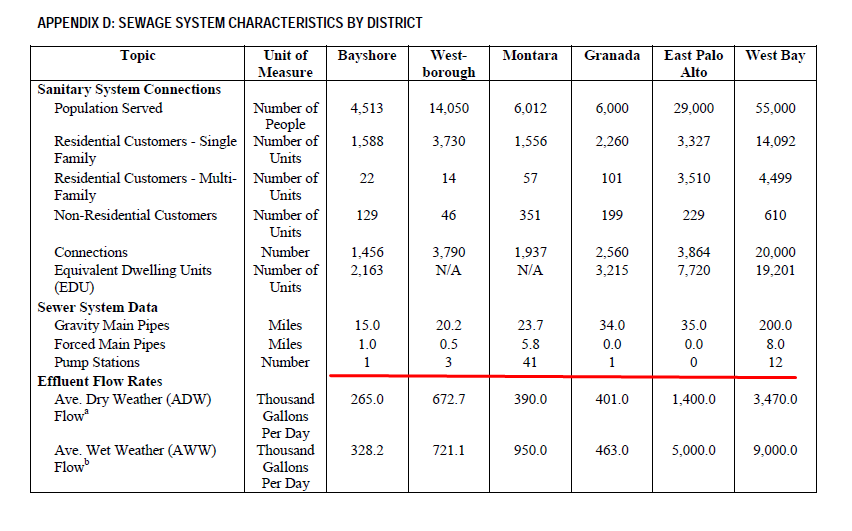
More From Gregg Dieguez ~ “InPerspective”
Mr. Dieguez is a semi-successful, semi-retired MIT entrepreneur who causes occasional controversy in the Coastside. He lives in Montara. He loves to respond to comments.




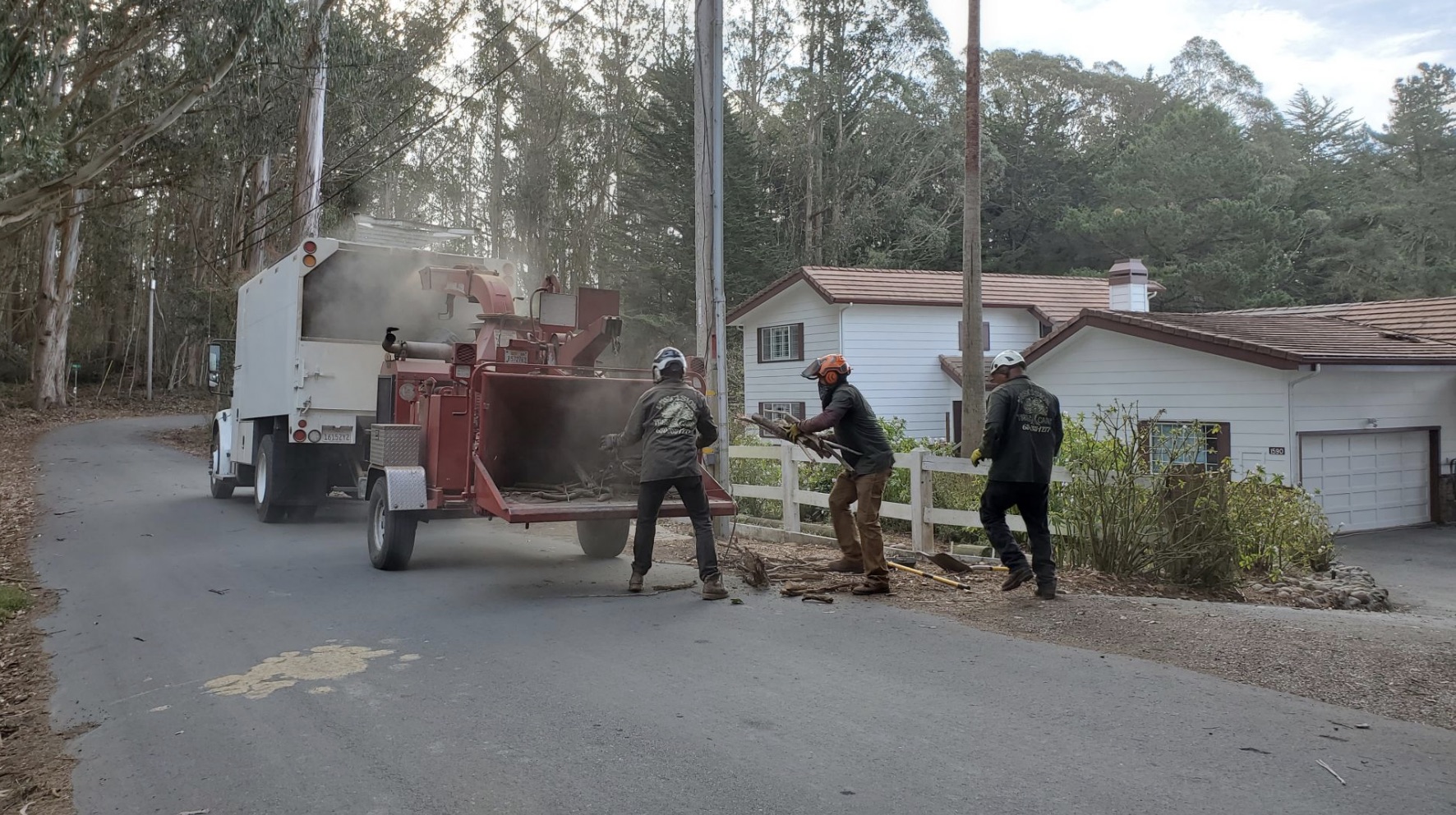

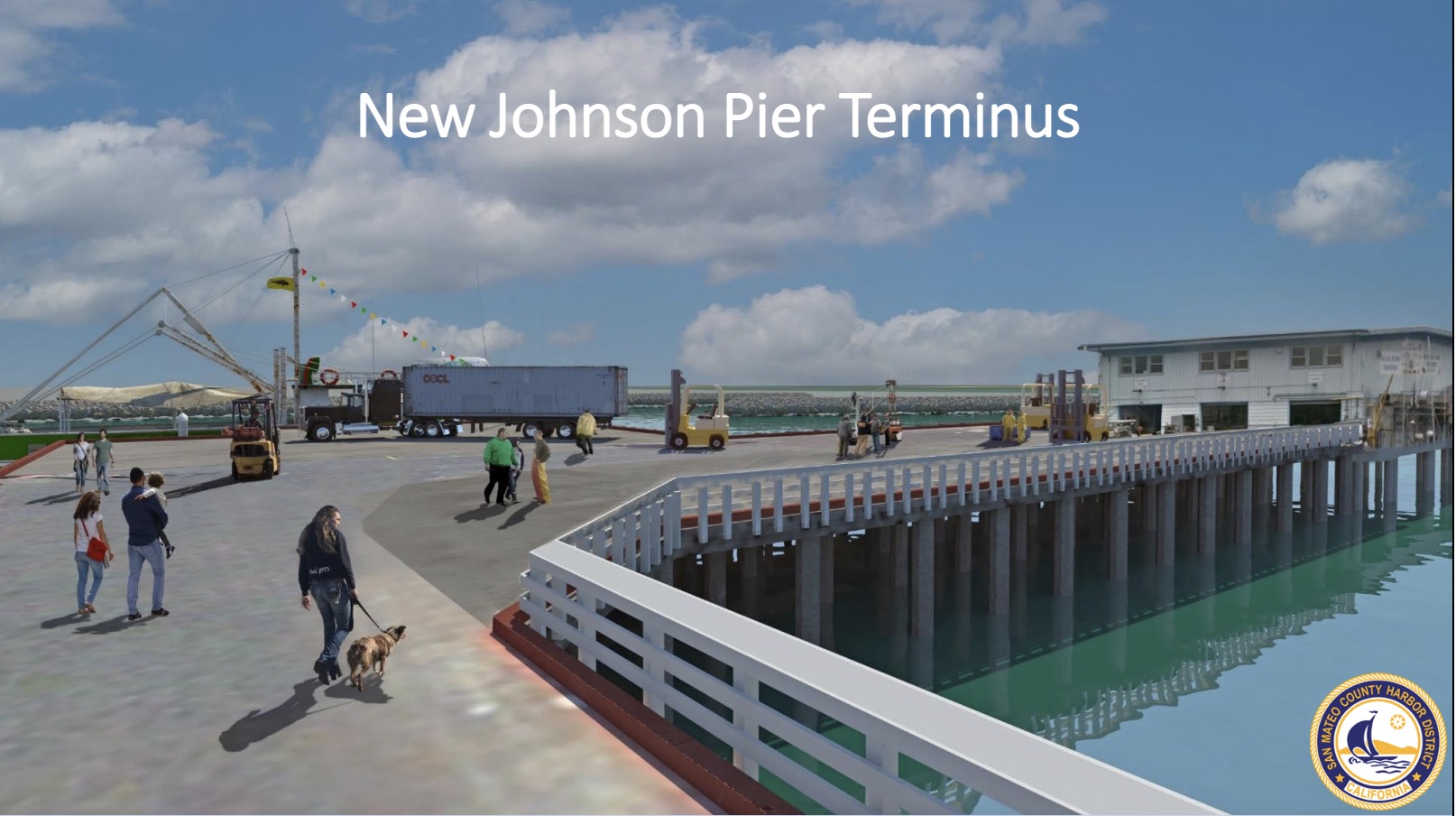
REGARDING THE MWSD RATE INCREASES
As a low volume user, I am subsidizing others because, despite my efforts to conserve, I am still charged a “minimum” rate, not based on actual usage, but whatever the District decides is the lowest tier they can afford to offer. Additionally, my water usage is 3 hcf per two month period, which is billed at tier one, ($8.36 per HCF) $25.08 HOWEVER, the other fee on my bill is called BASIC SERVICE and that is $57.60 for the two month cycle, and is charged, even if I do not consume a single drop of water. That is basically 70% of my bill and is a FEE while 30% of my bill is actually for water. Then, my Sewer Charge is also based on my water usage in the “Wet Weather” months, but NOT BASED on actual outflows either. I get charged the minimum rate, which is whatever they happen to decide the low-water users must pay.
Not exactly supportive of SENIORS WHO ARE ATTEMPTING TO LIVE SUSTAINABLY.
Cid, good to hear from you again. As I replied on ND, the infrastructure has to exist even if you don’t use a drop. What the correct balance is between fixed infrastructure and variable usage fees is a matter for deep consideration – and communication – with the latter most lacking. There is a related big issue having to do with the balance between Gentrification and Decay. I’ll be writing again on this topic, and have in prior weeks alerted the Board to some other ‘moral hazard’ issues we face with AirBnB, ADU’s, etc.